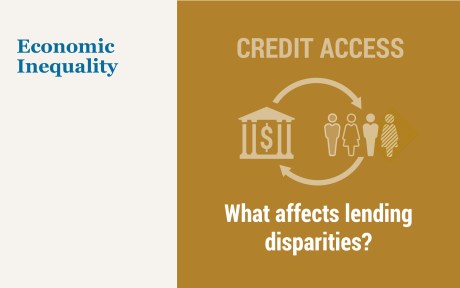
As covered in the first post in this series, the international transmission of monetary policy shocks features positive output spillovers when the so-called expenditure-switching effect is sufficiently large. Departing from textbook analysis, this post zooms in on the implications of differences across market participants with respect to their consumption preferences and ability to insure against income risk. The key message is that these features can, at least theoretically, change the impact of spillovers from positive to negative as well as alter their overall magnitude. These aspects of the international transmission mechanism are especially relevant when addressing spillovers from advanced to emerging economies.
Incorporating Household Heterogeneity
Let’s return to the thought experiment considered in the initial post. The working assumption is that interest rates abroad are temporarily higher than domestic rates. Other things being equal, this increases demand for assets denominated in the foreign currency and results in an initial depreciation of the real exchange rate in the home country followed by its appreciation over time. Real interest rates increase in both countries: in particular, the expected real exchange rate appreciation increases the real interest rate in the home economy and dampens the hike of its foreign equivalent. As considered in the previous post, the intertemporal-substitution channel and the expenditure-switching channel are now operational, with offsetting effects in the domestic economy according to the textbook model of spillovers.
Now, relative to the traditional models discussed earlier, we bring centerstage the rather obvious fact that households can differ from one another in terms of their marginal propensities to consume (MPC) out of their lifetime incomes. In other words, in each country access to asset and credit markets can differ across agents. Some households are able to borrow and save to smooth their consumption over time. Other households are unable to access financial markets, and they are forced to support their consumption spending by relying exclusively on their after-tax disposable incomes. The latter set of households—let’s call them hand-to-mouth (HtM) agents—have high MPCs (essentially equal to 1), while households with unconstrained access to capital markets display lower MPCs.
The Real-Income Channel
The key point for our assessment of spillovers is that the consumption behaviors of HtM and unconstrained home-country households differ in relation to their exposure to changes in the real exchange rate. When the exchange rate depreciates, all home-country households’ incomes fall in real terms as their purchasing power shrinks. But HtM households cannot access credit markets, so that the income fall translates into a one-to-one decline in consumption demand. In contrast, consumption by unconstrained agents is more insulated against the decline of purchasing power as their consumption depends on their lifetime income–not their current income. The presence of HtM households generates a non-standard channel of international transmission, a real-income channel that affects spillovers independently of the intertemporal-substitution channel. In fact, due to the real-income channel, home-country HtM households reduce their demand for domestic goods even though the intertemporal-substitution channel is not operational for this class of agents.
There is more. If nominal rigidities are in place and wages are sticky, the change in demand for domestic and foreign goods triggers a change in output. In turn, a change in output further modifies the current income of households. For HtM households with an MPC of 1, the change in income translates into a one-to-one change in consumption, leading to a textbook Keynesian multiplier effect similar to the one considered in the traditional Mundell-Fleming-Dornbusch paradigm.
In sum, the real-income and Keynesian multiplier effects, combined with the intertemporal-substitution channel, all contribute to a comprehensive expenditure-changing spillover effect on output (when the foreign country sneezes, the home country catches a cold). Our analysis suggests that for empirically relevant parameters, this is not enough to offset the expenditure-switching effect (increased foreign consumption of home goods). In other words, the sign of international spillovers is not affected by heterogeneity in MPCs. However, the size of spillovers can very much change as a function of the share of HtM agents in the economy. In fact, a higher fraction of HtM households—as is likely found in emerging market economies—tends to amplify the spillovers of a monetary tightening originating abroad.
Income Risk and the Precautionary Savings Channel
Next, we can consider a different dimension of agents’ heterogeneity and study what happens when households worldwide face uninsurable idiosyncratic income risk. What we mean by this is that at any point in time households face uncertainty about their future income. There is no insurance mechanism for unlucky agents facing adverse circumstances to be compensated through a transfer from agents facing favorable states of nature and higher incomes (note that the presence of such insurance market is the assumption underlying models featuring symmetric representative agents). Importantly, and realistically, income risk does change during the different stages of a business cycle, depending on the outlook for aggregate real activity: specifically, income risk is countercyclical (higher during a recession and lower during an expansion).
How does the analysis of spillovers change in a world with uninsurable income risk? In addition to the standard intertemporal-substitution and expenditure-switching channels, a different driver is now in play, a precautionary savings channel that captures the effect of a change in consumption risk following the policy shock. When households expect higher income risk in the future, they reduce their current spending and increase their desired level of savings. This reduced spending via the precautionary savings channel has the potential to affect international policy spillovers both qualitatively and quantitatively.
The precautionary savings channel involves two separate but interdependent dimensions. First, for a given level of income risk, how much consumption risk a household faces depends on the expected future path of real interest rates. To see how, consider what happens when workers temporarily lose their job. Without any current income, their households have two choices: reduce spending or borrow against future income to maintain their level of spending. The decision largely depends on the cost of borrowing. When real interest rates are expected to be low, households can borrow cheaply and maintain previous levels of spending until new employment is found. However, if real interest rates are expected to be high, it is too costly to borrow and the households choose to cut spending until a new source of income is secured. We refer to this as the self-insurance channel: a higher path of real interest rates makes it harder for households to self-insure, resulting in a higher passthrough of income risk to consumption risk. Thus, a contractionary monetary policy shock in the foreign economy increases consumption risk in the world economy, leading to reduced spending and hence lower GDP globally.
The other dimension of the precautionary savings channel is related to the idea that workers face a greater probability of becoming unemployed during recessions than during expansions, implying that households face greater income risk in recessions. If households expect the economy to enter a downturn, they reduce their spending and increase their desired level of precautionary savings. This reduction in spending further lowers output and makes the downturn more severe. Lower output abroad due to tighter monetary policy causes foreign households to cut back on their spending via the income risk channel. Importantly, foreign households not only cut back on purchases of domestic goods but also buy fewer imported goods. As a result, the decline in spending in the foreign economy due to tighter monetary policy can potentially be felt in the rest of the world, resulting in lower GDP worldwide.
The bottom line is that while the benchmark model features positive output spillovers when the expenditure-switching effect is sufficiently large, the precautionary savings channel can, at least theoretically, flip the sign of spillovers from positive to negative.
Read the final post in the series.
Sushant Acharya is an associate professor of economics at the University of Melbourne.

Ozge Akinci is head of International Studies in the Federal Reserve Bank of New York’s Research and Statistics Group.

Silvia Miranda-Agrippino is a research economist in the Federal Reserve Bank of New York’s Research and Statistics Group.

Paolo Pesenti is director of monetary policy in the Federal Reserve Bank of New York’s Research and Statistics Group.
How to cite this post:
Sushant Acharya, Ozge Akinci, Silvia Miranda-Agrippino, and Paolo A. Pesenti, “How Household Saving Affects Monetary Policy Spillovers,” Federal Reserve Bank of New York Liberty Street Economics, April 7, 2025, https://libertystreeteconomics.newyorkfed.org/2025/04/how-household-saving-affects-monetary-policy-spillovers/
BibTeX: View |
Disclaimer
The views expressed in this post are those of the author(s) and do not necessarily reflect the position of the Federal Reserve Bank of New York or the Federal Reserve System. Any errors or omissions are the responsibility of the author(s).













 RSS Feed
RSS Feed Follow Liberty Street Economics
Follow Liberty Street Economics